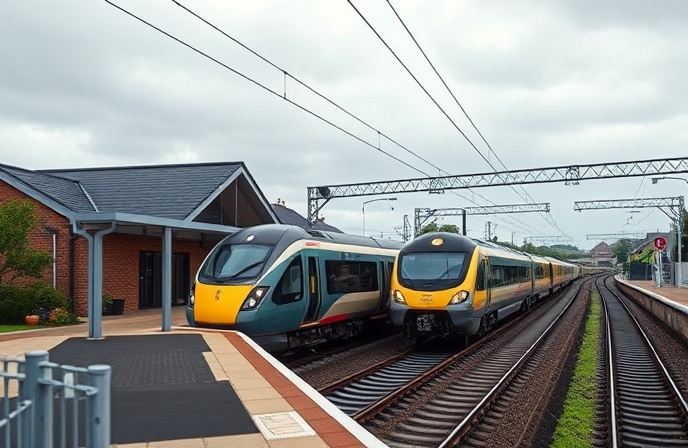Piedmont Rail Revival: Tech Drives Regional Growth

This article explores the revitalization of regional rail lines in Piedmont, Italy, focusing on the strategic partnership between Arenaways, a private Italian passenger rail operator, and Turnit, an Estonian provider of Software as a Service (SaaS) ticketing solutions. The collaboration highlights the increasing importance of technology in modernizing railway operations and enhancing the passenger experience. The reopening of the Cuneo-Savigliano and Ceva-Ormea lines, abandoned for passenger service in 2012, represents a significant investment in regional infrastructure and aims to boost tourism in the area. This case study will delve into the technical aspects of the ticketing system integration, the business strategies behind the project, and the potential impact on regional economic development. The analysis will examine the role of technology in overcoming previous challenges faced by Arenaways and the broader implications of this partnership for the future of open-access rail operations in Italy. The success of this project could serve as a model for other regions seeking to revitalize underutilized rail lines through innovative technological partnerships.
Revitalizing Piedmont’s Rail Network: A Technological Partnership
Arenaways, a private railway operator, has secured a contract to reopen two passenger lines in the Piedmont region of Northern Italy: the Cuneo-Savigliano and Ceva-Ormea lines. These lines, dormant since 2012, are slated for reactivation, with the Cuneo-Savigliano line projected to resume passenger services in early 2025, followed by the Ceva-Ormea line after the completion of necessary engineering works. This initiative aims to increase regional connectivity, stimulate tourism, and improve the lives of residents in the Piedmontese hills. The project showcases a commitment to revitalizing previously neglected rail infrastructure.
Turnit’s Role: A SaaS Solution for Seamless Ticketing
Central to the success of this rail line reactivation is the technology partnership with Turnit, a company specializing in SaaS (Software as a Service) solutions for the railway industry. Turnit provides Arenaways with its flagship product, Turnit Ride, a comprehensive ticketing and sales platform. This platform includes tools for ticket office management, a booking engine, and a dedicated mobile application for sales operators. The integration of this sophisticated system is crucial for providing a modern, user-friendly ticketing experience, addressing a major hurdle that contributed to the failure of Arenaways’ previous venture in 2010.
A Shared Vision: Passenger-Centric Approach
The success of this collaboration stems from a shared philosophy between Arenaways and Turnit. Both organizations prioritize a passenger-centric approach, emphasizing the importance of seamless and straightforward travel experiences. Matteo Arena, CEO of Arenaways, highlighted this shared commitment, emphasizing the meticulous attention to detail in building the service and Turnit’s ability to fully meet Arenaways’ stringent requirements. This alignment of values is essential for the long-term success of the project, ensuring that the technological solutions are effectively integrated with the operational aspects of the railway service.
Strategic Implications and Future Outlook
The Arenaways-Turnit partnership holds significant strategic implications for the Italian railway sector and beyond. The successful implementation of Turnit’s SaaS solution could serve as a blueprint for other open-access rail operators seeking to enhance their ticketing and customer service offerings. The project’s focus on technological innovation and passenger satisfaction could stimulate investment in regional rail infrastructure and encourage the reactivation of dormant lines across Italy. The emphasis on a user-friendly and efficient ticketing system is crucial for attracting riders and ensuring the financial viability of the reopened lines. The project’s success will depend on several factors, including effective marketing, competitive pricing, and ongoing maintenance of the railway infrastructure and the software system. Furthermore, the integration of the technology must seamlessly align with the operational needs of Arenaways to ensure smooth ticket sales and overall customer satisfaction.
Conclusions
The revitalization of the Cuneo-Savigliano and Ceva-Ormea rail lines in Piedmont, Italy, represents a significant undertaking, showcasing a strategic partnership between Arenaways and Turnit. This partnership goes beyond a simple technology contract; it signifies a shared commitment to enhancing the passenger experience through technological innovation. Arenaways’ previous attempt to operate a similar service failed due, in part, to insufficient technological infrastructure and a lack of a user-friendly ticketing system. The integration of Turnit’s SaaS platform, specifically Turnit Ride, addresses these previous shortcomings by providing a modern, efficient, and passenger-centric ticketing system. The shared philosophy of both organizations, focused on customer satisfaction and attention to detail, is critical to the long-term success of the project. The success of this initiative could prove to be a game-changer for regional rail services in Italy and potentially inspire similar projects across Europe, demonstrating the vital role of technological innovation in modernizing railway operations and enhancing regional connectivity. The emphasis on a passenger-centric approach, a robust ticketing system, and a strategic technology partnership highlight the crucial ingredients for revitalizing underutilized rail lines and boosting local economies. The careful consideration given to technological integration alongside operational realities sets a precedent for future rail modernization endeavors.





